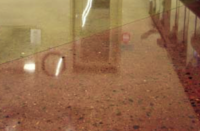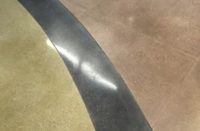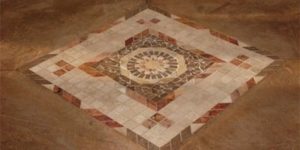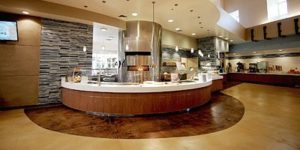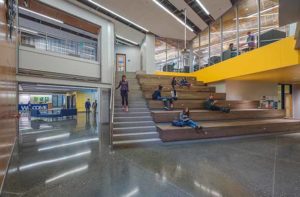
Every year, schools and municipalities spend millions of dollars replacing old worn-out carpet and vinyl composite tiles. The cost of replacing these traditional flooring materials is quite expensive and in most cases not at all green. Over the past several years more and more facilities are looking at polished concrete as a viable option. Why? Lower costs, simplified maintenance, greater longevity and true sustainability are key factors.
Although the benefits are very convincing, many are still reluctant to make the change from traditional flooring options. Some of the major concerns are noise, cost of polishing concrete, condition of the concrete (such as cracks) and the amount of time it takes to convert. That fear of the unknown has caused many to go with what they know and stay with carpet or vinyl flooring.
Guards are good
Tony Almeida, manager of custodial services at Elk Grove Unified School District in Sacramento, California, says the challenge of converting to polished concrete has been strictly cultural. Some administrators struggle with the perception of polished concrete.
Aesthetics are a definite factor. There’s a concern the finished product will appear too institutional or modern. It has taken years of testing to find a system that works well for the district. Interestingly, Almeida says 90 percent of the time when they go back to an area that’s been polished, staff say they love their floors and wouldn’t change for anything.
One of the major concerns in polishing classrooms are the scratches caused by moving furniture, particularly student desks, tables and stools. Even a rock-hard concrete floor will scratch. Almeida recommends putting floor glides on the legs of desks, chairs and tables to help reduce scarring the surface.
Just like with any flooring, entrance mats can also help to preserve the appearance and lower the overall maintenance costs. Most importantly using a quality guard product that protects the concrete from staining and is easily maintained and reparable is vital. “If you find a guard that reduces your labor and need for stripping, then life is good!” he says.
Restoring is easier
When weighing the cost of maintenance against traditional flooring, facilities should consider what’s involved in restoring the floor, what environment the floor will be exposed to, the health benefits and the costs to maintain the current flooring.
For example, if a school is in a more rural area it might deal with more sand and dust. Carpet traps the sand causing the fibers to break down faster. In addition, the trapped dirt and dust when disturbed adds allergens into the air.
In most cases, a school only has a few weeks in the summer to extract the carpet with equipment that doesn’t get it all out. Even though the sand will scratch the polished concrete, the cost to restore it is significantly cheaper in the long run and it will never need to be replaced like carpet.
Acoustics and sustainability
The second perceived issue at Elk Grove was the acoustics. Just as with aesthetics, the issue of noise is really a matter of perception. For many years, vinyl composite tiles were the standard in classrooms. The noise level in those classrooms isn’t much different than a classroom with polished concrete.
Elk Grove has found that splitting the room with a combination of flooring options has helped to alleviate those concerns. “You have to understand that every environment is different and every floor is different,” Almeida says. “Polished concrete is just one of many standards now available for our schools.”
However, one of the biggest benefits he sees to using polished concrete is sustainability. “That plays a huge part in our decision. We are not sending another floor into the landfill 10 years down the road.”
Maintenance goes a long way
An example of how making the switch to polished floors has paid off is that of Stockton Metropolitan Airport in California. In fall 2013, Harry Mavrogenes, airport director, had been contemplating a cosmetic overhaul that would completely replace the terminal buildings’ carpet. Bill Fields, owner and founder of Surtec Inc., met with him and identified that under the old, worn-out carpet squares was a cementitious terrazzo floor.
This propelled the prospect of restoring the underlying terrazzo floor, rather than replacing the carpet. Stripping and polishing tests were conducted and the decision was made to restore the original terrazzo floor, saving tens of thousands of tax dollars.
Surtec assisted the airport and local contractor, DCS Facility Services, with products, training and technical support throughout the restoration process. Now four years later, with only basic maintenance, the floor still looks great. This past year, DCS Facility Services came back and refreshed the floor. “We expect that our floors will continue to look like a million dollars for years to come!” Mavrogenes says.
“By moving to a polished concrete floor, you can lower your cost of maintenance,” says Greg Brown, owner and president of Finished Floors in Sacramento, a company that specializes in working with schools and health care facilities.
Over the years, the company has restored various flooring systems such as ceramic tile, resilient flooring and recently polished concrete. “Resilient covered floors require a lot of preventative and corrective maintenance to maintain the quality,” Brown says. “Opting for a polished concrete floor means much easier maintenance.” Not to mention, he adds, “Concrete has a personality.”

A little at a time
What about the cost and time it takes to remove old flooring and polish the concrete? Instead of doing it all at once, Elk Grove Unified School District began a program of steadily converting rooms as needed.
To save money, it used its own staff and sought out training. They attended workshops hosted by their vendors and developed a program that helped greatly reduce maintenance costs. Almeida says that when given the choice between polishing the existing concrete or waiting for funds to replace the carpet, it’s a no brainer — polish the concrete!
Although carpet still makes up a large part of the flooring that’s being put down in schools, universities and public facilities, polished concrete is making strides as an alternative. In high-traffic areas, lobbies, entrances and classrooms, it’s proving to be a great flooring option.
With the help of vendors that can train staff, many in the public sector are finding it’s not nearly as difficult a transition as once thought. In many cases, the initial grinding and polishing can be outsourced and still cost less than installing carpet. The facility can easily maintain the floor with a huge savings.
In a nutshell, with proper training on how to maintain polished concrete — and with the latest in densifiers and guards — polished concrete is attractive, easier to maintain and less costly than most other flooring options.

